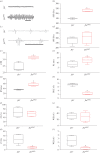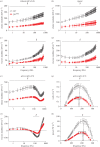Flightin maintains myofilament lattice organization required for optimal flight power and courtship song quality in Drosophila
- PMID: 28469022
- PMCID: PMC5443953
- DOI: 10.1098/rspb.2017.0431
Flightin maintains myofilament lattice organization required for optimal flight power and courtship song quality in Drosophila
Abstract
The indirect flight muscles (IFMs) of Drosophila and other insects with asynchronous flight muscles are characterized by a crystalline myofilament lattice structure. The high-order lattice regularity is considered an adaptation for enhanced power output, but supporting evidence for this claim is lacking. We show that IFMs from transgenic flies expressing flightin with a deletion of its poorly conserved N-terminal domain (flnΔN62 ) have reduced inter-thick filament spacing and a less regular lattice. This resulted in a decrease in flight ability by 33% and in skinned fibre oscillatory power output by 57%, but had no effect on wingbeat frequency or frequency of maximum power output, suggesting that the underlying actomyosin kinetics is not affected and that the flight impairment arises from deficits in force transmission. Moreover, we show that flnΔN62 males produced an abnormal courtship song characterized by a higher sine song frequency and a pulse song with longer pulses and longer inter-pulse intervals (IPIs), the latter implicated in male reproductive success. When presented with a choice, wild-type females chose control males over mutant males in 92% of the competition events. These results demonstrate that flightin N-terminal domain is required for optimal myofilament lattice regularity and IFM activity, enabling powered flight and courtship song production. As the courtship song is subject to female choice, we propose that the low amino acid sequence conservation of the N-terminal domain reflects its role in fine-tuning species-specific courtship songs.
Keywords: Drosophila; courtship song; fibre mechanics; flight muscle; flightin; myofilament lattice.
© 2017 The Author(s).
Conflict of interest statement
There are no competing interests.
Figures




Similar articles
-
COOH-terminal truncation of flightin decreases myofilament lattice organization, cross-bridge binding, and power output in Drosophila indirect flight muscle.Am J Physiol Cell Physiol. 2011 Aug;301(2):C383-91. doi: 10.1152/ajpcell.00016.2011. Epub 2011 May 18. Am J Physiol Cell Physiol. 2011. PMID: 21593450 Free PMC article.
-
Flight muscle properties and aerodynamic performance of Drosophila expressing a flightin transgene.J Exp Biol. 2005 Feb;208(Pt 3):549-60. doi: 10.1242/jeb.01425. J Exp Biol. 2005. PMID: 15671343
-
Site directed mutagenesis of Drosophila flightin disrupts phosphorylation and impairs flight muscle structure and mechanics.J Muscle Res Cell Motil. 2007;28(4-5):219-30. doi: 10.1007/s10974-007-9120-y. Epub 2007 Oct 3. J Muscle Res Cell Motil. 2007. PMID: 17912596
-
Courtship song analysis of Drosophila muscle mutants.Methods. 2012 Jan;56(1):87-94. doi: 10.1016/j.ymeth.2011.09.007. Epub 2011 Sep 16. Methods. 2012. PMID: 21945578 Review.
-
The function of elastic proteins in the oscillatory contraction of insect flight muscle.J Muscle Res Cell Motil. 2005;26(6-8):479-85. doi: 10.1007/s10974-005-9032-7. J Muscle Res Cell Motil. 2005. PMID: 16450058 Review.
Cited by
-
Developmental remodelling of Drosophila flight muscle sarcomeres: a scaled myofilament lattice model based on multiscale morphometrics.Open Biol. 2025 Aug;15(8):250182. doi: 10.1098/rsob.250182. Epub 2025 Aug 13. Open Biol. 2025. PMID: 40795996 Free PMC article.
-
Contiguity and Structural Impacts of a Non-Myosin Protein within the Thick Filament Myosin Layers.Biology (Basel). 2021 Jul 2;10(7):613. doi: 10.3390/biology10070613. Biology (Basel). 2021. PMID: 34356468 Free PMC article.
-
Age-Related Changes of Gene Expression Profiles in Drosophila.Genes (Basel). 2021 Dec 14;12(12):1982. doi: 10.3390/genes12121982. Genes (Basel). 2021. PMID: 34946931 Free PMC article.
-
Making waves: A proposed new role for myosin-binding protein C in regulating oscillatory contractions in vertebrate striated muscle.J Gen Physiol. 2021 Mar 1;153(3):e202012729. doi: 10.1085/jgp.202012729. J Gen Physiol. 2021. PMID: 33275758 Free PMC article.
-
Secondary Structure of the Novel Myosin Binding Domain WYR and Implications within Myosin Structure.Biology (Basel). 2021 Jun 29;10(7):603. doi: 10.3390/biology10070603. Biology (Basel). 2021. PMID: 34209926 Free PMC article.
References
-
- O'Connor JK, Li DQ, Lamanna MC, Wang M, Harris JD, Atterholt J, You HL. 2016. A new early cretaceous Enantiornithine (Aves, Ornithothoraces) from northwestern China with elaborate tail ornamentation. J. Vertebr. Paleontol. 36, e1054035 (10.1080/02724634.2015.1054035) - DOI
-
- Grimaldi D, Engel MS. 2005. Evolution of the insects. Cambridge, UK: Cambridge University Press.
-
- Ewing AW. 1989. Arthropod bioacoustics: neurobiology and behavior. Ithaca, NY: Cornell University Press.
-
- Ewing AW, Bennet-Clark HC. 1977. The neuromuscular basis of courtship song in Drosophila: the role of the indirect flight muscles. J. Comp. Physiol. 119, 249–265. (10.1007/BF00656637) - DOI
MeSH terms
Substances
LinkOut - more resources
Full Text Sources
Other Literature Sources
Molecular Biology Databases
Research Materials
Miscellaneous

